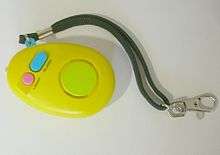Personal alarm

A personal alarm is a small hand-held electronic device with the functionality to emit a loud siren-like alarming sound. It is activated either by a button, or a tag that, when pulled, sets the siren off.[1]
It is used to attract attention in order to scare off an assailant.[2] The sound emitted can also have the effect of distracting, disorienting, or surprising the assailant.
The volume varies from model to model, with some models having 130 decibels. Some personal alarms are also outfitted with an LED light for normal lighting purposes or to help deter an assailant. Due attention must be given to the fact that these devices can give a 'false sense of security' and therefore place the individual in danger.
Some personal safety apps emit a loud intermittent "shrill whistle", in the manner of a personal alarm.[3]
Background
According to Rape, Abuse & Incest National Network “every 98 seconds, an American is sexually assaulted. And every 8 minutes, that victim is a child. Meanwhile, only 6 out of 1,000 perpetrators will end up in prison.” [4][5]
Help Save the Next Girl, a national non-profit organization formed in honor of an abducted and brutally murdered college student, Morgan Dana Harrington, actively participates in endorsing legislation which increases safety concerns in the community. Members of the organization offered a list of tips [6] on how to stay safe when going out, especially at night; a few of those tips suggested putting pepper spray or gel and a strong whistle on the keychain. More safety tips can be found at the official website of Virginia State Police [7]
The Alumnae Association of Smith College specifically recommended the use of personal alarms to help students in emergency situations. [8]
According to National Council on Aging, “falls are the leading cause of fatal and non-fatal injuries for older Americans.” [9] The study, published in the International Journal of General Medicine, claims that “personal alarms are an effective strategy when used appropriately to prevent laying on the ground for a long time after a fall and to obtain immediate assistance.” [10]
Ramsey Student Center along with the American Red Cross offered a list of tips for hiking and camping, including a suggestion to invest in an alarm with GPS, especially if a person is to travel alone. [11]
Types of personal alarms
To activate an alarm, the user will have to press a button or pull the pin. To turn off the alarm, insert the pin back. Users should read the instructions for each particular device as they could vary.
The units are small and intended to be carried at all times. Basic options for personal alarms are a pendant to wear around the neck, smart watch worn on the wrist, an alarm pager that can be attached to a keychain, bag, or elsewhere. Some gadgets have additional features that include the torch, GPS trackers, two-way and hands free communication, fall detection, geo fencing, among others [12].
Usage
According to the Suzy Lamplugh Trust, the best way to use a personal alarm is to activate it, to drop it on the floor near the assailant, and then to immediately run away.[13]
Since students are the common targets for perpetrators, they should carry personal safety alarms at all times. The problem of safety at college and university campuses is becoming more recognized by the educational administration. Thus, the Department of Public Safety of Brown University made personal safety alarms free for all students [14].
Children’s personal alarms should be easy to use, colorful and practical in design, so the child enjoys wearing it. It is recommended that the parent trains a child for a while and instructs him/her on how to use it, so the child is up to the task, if need be.
Car drivers may prefer keychain alarms as they are exposed to the risk of an assault when getting in or out of the car. [15]
Elderly people with limited mobility should carry an alarm with a fall detection feature; with Alzheimer’s or dementia – an alarm with geo tracking, in case the elderly can’t communicate their location. [12] Elderly or disabled who live at home should carry medical alarms.
Joggers, cyclists, or other sports enthusiasts training at night, as well as travelers who might be attacked by an aggressive animal, should carry a device with GPS and a shrill sound to scare off either a human assailant or animal. [15]
See also
References
- ↑ http://www.dlf.org.uk/factsheets/telecare
- ↑ http://devconhomesecurity.com/blog/looking-personal-alarms-elderly-heres-consider
- ↑ Distress apps: How safe?
- ↑ "Scope of the problem". Focal Press.
- ↑ Rape, Abuse & Incest National Network
- ↑ "Safety Tips". James Madison University.
- ↑ "Safety Tips". Virginia State Police.
- ↑ "Whatever They Told You About Safe Sound Personal Alarm Is Dead Wrong... And Here's Why, Smith College Alumnae Relations". Smith College Alumnae Relations.
- ↑ "Falls Prevention Facts". National Council on Aging.
- ↑ "Perspectives on use of personal alarms by older fallers". Int J Gen Med.
- ↑ "Health & Safety Tips. Hiking and Camping Safety" (PDF). Ramsey Student Center.
- 1 2 "Personal alarm buying guide". Choice.
- ↑ "Personal alarms". London, England: Suzy Lamplugh Trust.
- ↑ "Personal Safety Alarms. Department of Public Safety". Brown University.
- 1 2 "15 Safesound Personal Alarms". My Personal Defence.